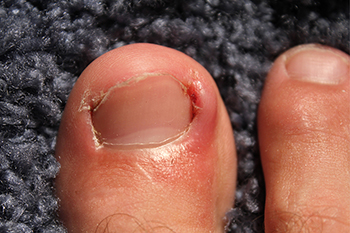Middlefield (860) 349-8500
Wallingford (203) 294-4977
Middlefield (860) 349-8500
Wallingford (203) 294-4977

Having an ingrown toenail is a common cause of toe pain. Most ingrown toenails are located on the big toe, resulting in the nail growing into the flesh surrounding it. This results in redness, swelling, and pain. In some cases, the area can become infected, which causes a discharge and pus to form. Experts recommend a few at-home methods to ease the pain and reduce the chances of infection. First soak the foot in warm, salty water to loosen the surrounding skin. Then thoroughly dry the foot and wear wide or open-toed shoes that do not press on the big toe. To prevent getting an ingrown toenail, it is recommended that your toenail be cut straight across and not too short. If the ingrown toenail has become infected or severely painful, it is a good idea to visit a podiatrist. This foot specialist can take measures to alleviate the pain, with the last resort of removing part or all of the toenail. Pain medication and antibiotics, in cases of infection. can also be prescribed by a podiatrist.
Ingrown toenails can become painful if they are not treated properly. For more information about ingrown toenails, contact Dr. Gordon Fosdick of Affiliated Foot Care Center. Our doctor can provide the care you need to keep you pain-free and on your feet.
Ingrown Toenails
Ingrown toenails occur when a toenail grows sideways into the bed of the nail, causing pain, swelling, and possibly infection.
Causes
Prevention
Because ingrown toenails are not something found outside of shoe-wearing cultures, going barefoot as often as possible will decrease the likeliness of developing ingrown toenails. Wearing proper fitting shoes and using proper cutting techniques will also help decrease your risk of developing ingrown toenails.
Treatment
Ingrown toenails are a very treatable foot condition. In minor cases, soaking the affected area in salt or antibacterial soaps will not only help with the ingrown nail itself, but also help prevent any infections from occurring. In more severe cases, surgery is an option. In either case, speaking to your podiatrist about this condition will help you get a better understanding of specific treatment options that are right for you.
If you have any questions please feel free to contact our offices located in Middlefield and Wallingford, CT . We offer the newest diagnostic and treatment technologies for all your foot and ankle needs.